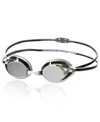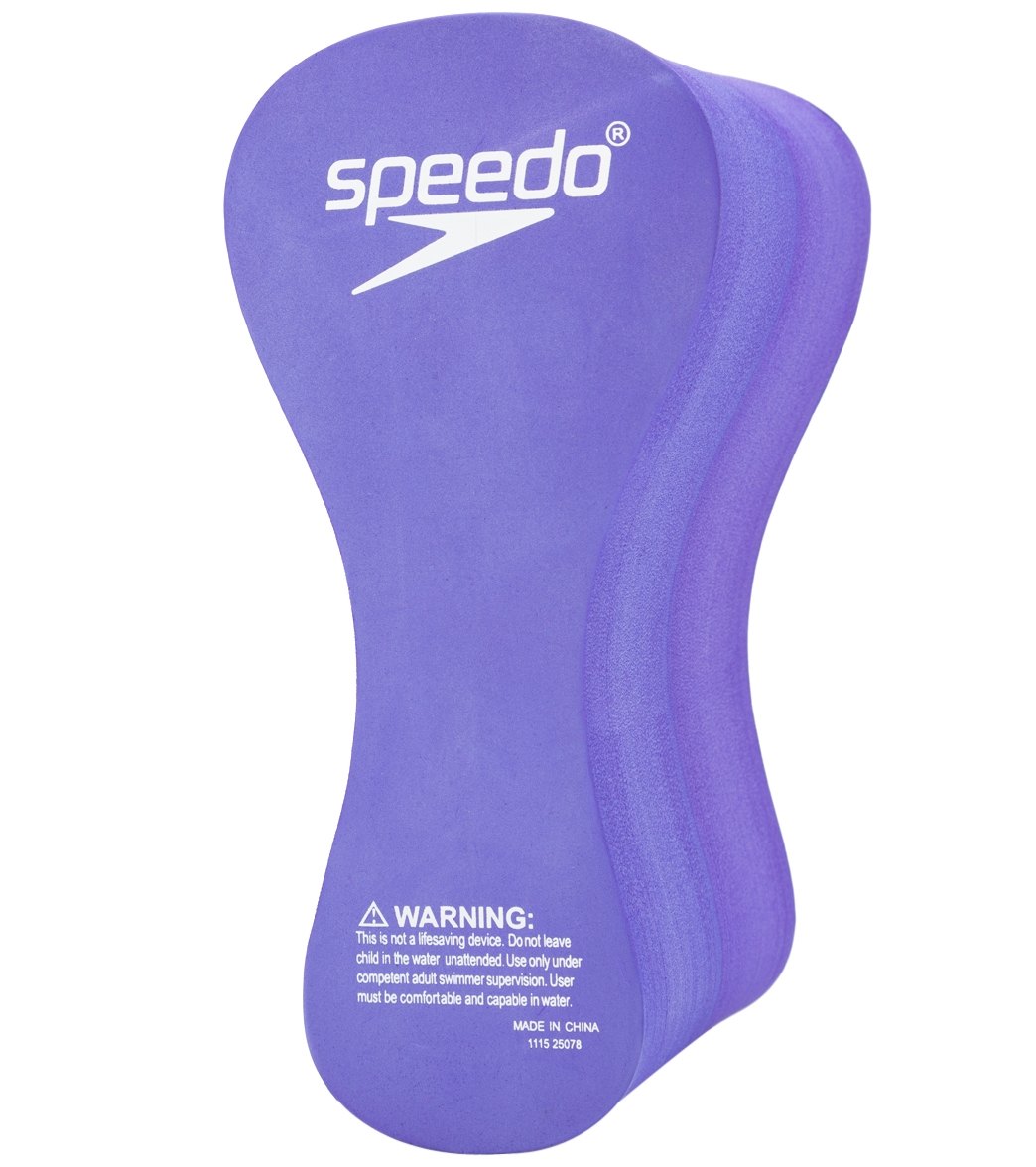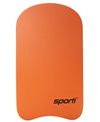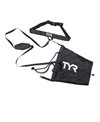What Muscles Are Used in Swimming?
First lets talk about what muscles you use in swimming. This diagram, although in Spanish is readily decipherable and a very good illustration of which muscles are important for each stroke.
This was posted by Mateo Fernandez on Twitter. (@mateofernandezz) He appears to be a sports commentator. Still, this diagram is a great, quick way to learn what muscles you need for swimming well. Just in case you still can't make heads or tails of it,
GREEN is Crawl,
BLUE is Back Stroke,
YELLOW is Breast Stroke,
RED is Butterfly and
WHITE is All Strokes.
Since we normally do Crawl or Free Style, the Green and White muscles are the ones you should focus your weight lifting or other activities on to build strength and power in the water.
Here's a focused diagram for Free Style; not all the muscles are labelled however:
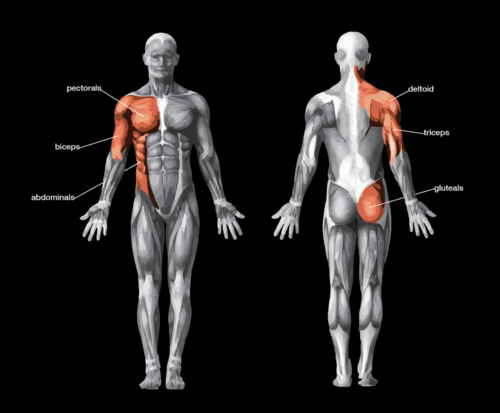
These muscles are
Triceps (smallest arm muscle on outer bicep area)
Biceps (Slangily referred to as your "guns")
Pectorals (Upper chest muscles)
Deltoid (Upper shoulder muscle)
Abdominals (Core for pulling)
Lats (Latisimus Dorsi Middle back muscles)
Traps (Trapezius top of shoulder into the neck)
Glutes (Gluteaus Maximus, your butt is used to keep the legs level and kick)
Note that neither diagram highlights the leg muscles as particularly important for freestyle power.
Many beginners think they need to kick furiously to go faster in the freestyle but if you watch Olympians and faster swimmers, you'll note that they use a flutter kick to keep the legs level but are not often kicking or making a lot of slashes. Watch this video of Katie Ledecky and note how much her kick differs from the other swimmers. One reason is that kicking doesn't provide a lot of forward momentum and they use a large amount of energy. So conserve your energy and your legs for the bike and run by learning how to get fast using your core, back, and arm muscles.
What strength training should you do to support your faster swim goals?
One more pre-lesson. Take a quiz...how much do you know about Muscles and Strength Training? How does strength training work? By loading the muscle with weight or stress that requires it to work harder than normal, you are actually tearing the muscle fibers apart. The muscle then rebuilds itself during the rest period and adds more fibers that can then lift heavier weight. In six weeks, if you are doing it correctly, you should see changes to your tone and your strength. Correctly lifting means training a set of muscles and giving them at least a day of rest and stretching after the session. Both of these are very important to building muscle without injury.
Nutrition is also important so make sure you are getting enough good food to rebuild. Some body builders take their nutrition to very basic levels but you simply need to assure you have sufficient protein and nutrients and Hydrate!
Static and Dynamic Stretches for Swimmers Here's a good demonstration of how to stretch pre and post-workout. Learn the difference between static and dynamic stretching here. Use dynamic stretches pre-workout and static after the workout.
Fast Body Weight Workout for Swimmers Using your own body weight can be a great way to keep up your strength training during travel. If the hotel gym is limited or you are not able to get to the gym, taking 10 minutes after a long day can keep your fitness moving forward. Remember to stretch and give your body time to recover.
Par Cours For Swimmers This is the kind of workout that Coach Masumi likes to include in her coaching. It requires that you swim and hop out to do some sort of bodyweight training after each set. You can also use the Par Cours spots on your weekly runs to help you build muscle for your swimming combining your outside run with strength training. On days when being outside is just too tempting (great fall days are optimal for this) don't pass up the Par Cours spots..try to incorporate what you learned here to add 30 reps of some activity at each stop. You could even use a HIIT technique by racing to each Par Cours location, doing the reps and resting for 30-60 secs before heading to the next spot. The Lakefront Trail along Lake Michigan has many Par Cours locations.
Dryland HIIT Class for Swimmers This is for those that just don't feel like much is going on unless they exhaust themselves in a workout. I disagree and believe that a variety of workouts, some workouts where you walk away feeling like you could do more and others where you can barely make it out of the gym are important. But, if you are that young, Type A, master of the universe, this workout could be for you.
HIIT Class for Swimmers While there is dryland HIIT class, the science of HIIT can also be used in the pool. I think you'll see that it is focused on speed and those very muscles that we have been discussing here. This is an article, not a video that discusses the science behind HIIT and how it can help as well as the scientific aspects of VO2 Max training.
Stretching for Weightlifters and Runners Any workout should include a stretch at least after the workout. You may want to do some before, but dynamic stretches have been shown to be better than static which are shown here.
Recovery Over 50 Athletes Under 50 Athletes The bottom line for recovery is to respect your rest days and alternate activities so you give the stressed muscles time to rebuild. Doing otherwise risks overtraining and injuries that can end a season.
Over 50 Notes
 A note for older athletes, after 50 you begin to need more weight lifting to retain body mass and tone. If you have never done weight lifting, I recommend a fitness trainer to learn how to do this safely. The header is an article on training for over 50 athletes that may also help. As I mentioned above, the worst thing newbies do is choose too much weight. That can tear your muscles too much and put you out of commission for a week or more which accomplishes nothing. Start light and add slowly. Try for three days per week to begin with rest days between. You should NOT feel overly stiff or sore the next day. DOMS (Delayed Onset Muscle Soreness) is a thing and usually happens the next day or the day after that. Stretching after you exercise and the day after can reduce this so you can keep going back. The goal should be to add a small bit of weight after each set. Example: Begin with 5 lbs for bench press, one in each hand. Do 10 reps. Choose 7.5 lbs for the next 10 reps and 10 lbs for the third set. Next week you may start with 7.5 lbs. At some point you will hit a plateau and remain there for a while. Keep trying to add weight but drop down if it's too much for all 10 reps. Plateaus are okay...Just keep going. At the end of the training, stretch those muscles using Yoga or simple stretching techniques shown in the videos in this blog. The athlete is the photo is Bill Pritchitt who is over 50. Click on the link to read more about him.
A note for older athletes, after 50 you begin to need more weight lifting to retain body mass and tone. If you have never done weight lifting, I recommend a fitness trainer to learn how to do this safely. The header is an article on training for over 50 athletes that may also help. As I mentioned above, the worst thing newbies do is choose too much weight. That can tear your muscles too much and put you out of commission for a week or more which accomplishes nothing. Start light and add slowly. Try for three days per week to begin with rest days between. You should NOT feel overly stiff or sore the next day. DOMS (Delayed Onset Muscle Soreness) is a thing and usually happens the next day or the day after that. Stretching after you exercise and the day after can reduce this so you can keep going back. The goal should be to add a small bit of weight after each set. Example: Begin with 5 lbs for bench press, one in each hand. Do 10 reps. Choose 7.5 lbs for the next 10 reps and 10 lbs for the third set. Next week you may start with 7.5 lbs. At some point you will hit a plateau and remain there for a while. Keep trying to add weight but drop down if it's too much for all 10 reps. Plateaus are okay...Just keep going. At the end of the training, stretch those muscles using Yoga or simple stretching techniques shown in the videos in this blog. The athlete is the photo is Bill Pritchitt who is over 50. Click on the link to read more about him.Happy Swimming folks. Take advantage of the post season and build those muscles. Turkey or Vegan Tofurky are full of plenty of protein that can help build muscle for a future great swim!
